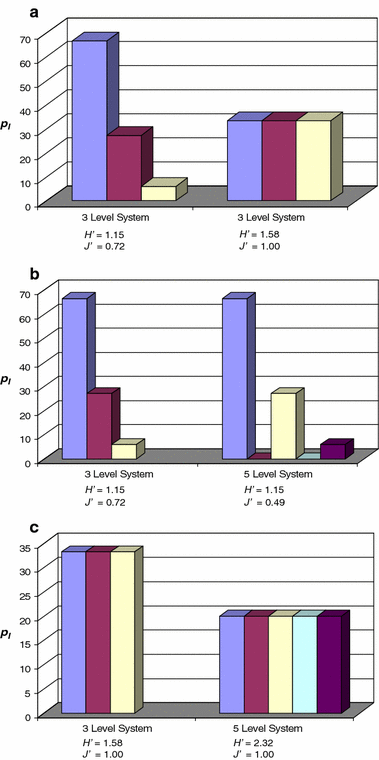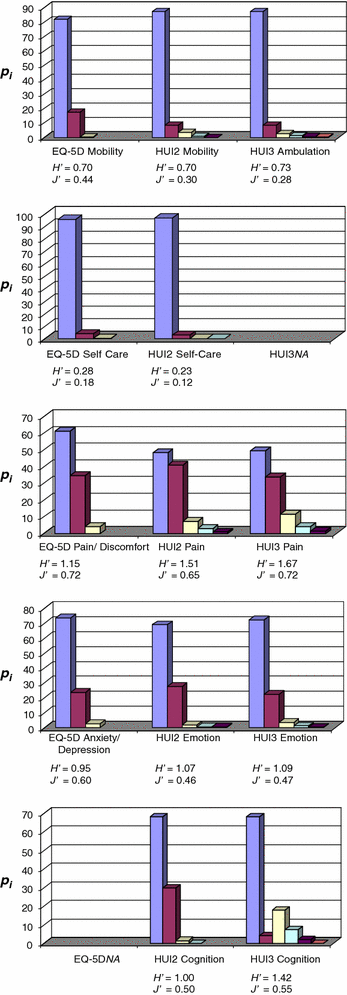Evaluating the discriminatory power of EQ-5D, HUI2 and HUI3 in a US general population survey using Shannon's indices
- PMID: 17294285
- PMCID: PMC1915610
- DOI: 10.1007/s11136-006-9160-6
Evaluating the discriminatory power of EQ-5D, HUI2 and HUI3 in a US general population survey using Shannon's indices
Abstract
Objectives: To compare quantitatively the discriminatory power of the EQ-5D, HUI2 and HUI3 in terms of absolute and relative informativity, using Shannon's indices.
Methods: EQ-5D and HUI2/3 data completed by a sample of the general adult US population (N = 3,691) were used. Five dimensions allowed head-to-head comparison of informativity: Mobility/Ambulation; Anxiety/Depression/Emotion; Pain/Discomfort (EQ-5D; HUI2; HUI3); Self-Care (EQ-5D; HUI2); and Cognition (HUI2; HUI3). Shannon's index and Shannon's Evenness index were used to assess absolute and relative informativity, both by dimension and by instrument as a whole.
Results: Absolute informativity was highest for HUI3, with the largest differences in Pain/Discomfort and Cognition. Relative informativity was highest for EQ-5D, with the largest differences in Mobility/Ambulation and Anxiety/Depression/Emotion. Absolute informativity by instrument was consistently highest for HUI3 and lowest for EQ-5D, and relative informativity was highest for EQ-5D and lowest for HUI3.
Discussion: Performance in terms of absolute and relative informativity of the common dimensions of the three instruments varies over dimensions. Several dimensions are suboptimal: Pain/Discomfort (EQ-5D) seems too crude with only 3 levels, and the level descriptions of Ambulation (HUI3) and Self-Care (HUI2) could be improved. In absence of a formal measure, Shannon's indices provide useful measures for assessing discriminatory power of utility instruments.
Figures


Similar articles
-
Relative efficiency of the EQ-5D, HUI2, and HUI3 index scores in measuring health burden of chronic medical conditions in a population health survey in the United States.Med Care. 2009 Jan;47(1):53-60. doi: 10.1097/MLR.0b013e31817d92f8. Med Care. 2009. PMID: 19106731
-
Comparison of three societally derived health-state classification values among older African Americans with depressive symptoms.Qual Life Res. 2013 Aug;22(6):1491-8. doi: 10.1007/s11136-012-0263-y. Epub 2012 Sep 13. Qual Life Res. 2013. PMID: 22972437 Free PMC article.
-
Measurement properties of EQ-5D-3L and EQ-5D-5L in recording self-reported health status in older patients with substantial multimorbidity and polypharmacy.Health Qual Life Outcomes. 2020 Sep 29;18(1):317. doi: 10.1186/s12955-020-01564-0. Health Qual Life Outcomes. 2020. PMID: 32993637 Free PMC article. Clinical Trial.
-
A review of the psychometric properties of generic utility measures in multiple sclerosis.Pharmacoeconomics. 2014 Aug;32(8):759-73. doi: 10.1007/s40273-014-0167-5. Pharmacoeconomics. 2014. PMID: 24846760 Review.
-
A Review of the Psychometric Performance of Selected Child and Adolescent Preference-Based Measures Used to Produce Utilities for Child and Adolescent Health.Value Health. 2021 Mar;24(3):443-460. doi: 10.1016/j.jval.2020.09.012. Epub 2020 Nov 7. Value Health. 2021. PMID: 33641779 Review.
Cited by
-
The added value of the EQ-5D with a cognition dimension in injury patients with and without traumatic brain injury.Qual Life Res. 2019 Jul;28(7):1931-1939. doi: 10.1007/s11136-019-02144-6. Epub 2019 Feb 28. Qual Life Res. 2019. PMID: 30820809 Free PMC article.
-
Comparing the performance of the standard EQ-5D 3L with the new version EQ-5D 5L in patients with chronic hepatic diseases.Qual Life Res. 2013 Sep;22(7):1707-16. doi: 10.1007/s11136-012-0318-0. Epub 2012 Nov 29. Qual Life Res. 2013. PMID: 23192232
-
A head-to-head comparison of five-level (EQ-5D-5L-Y) and three-level EQ-5D-Y questionnaires in paediatric patients.Eur J Health Econ. 2019 Jul;20(5):647-656. doi: 10.1007/s10198-018-1026-7. Epub 2019 Jan 2. Eur J Health Econ. 2019. PMID: 30600469
-
Validation of the EQ-5D-Y-5L parent-proxy version among children with juvenile idiopathic arthritis.Qual Life Res. 2024 Oct;33(10):2677-2691. doi: 10.1007/s11136-024-03682-4. Epub 2024 Aug 14. Qual Life Res. 2024. PMID: 39141175 Free PMC article.
-
Comparing the psychometric properties of the EQ-5D-3L and EQ-5D-5L descriptive systems and utilities in atopic dermatitis.Eur J Health Econ. 2023 Feb;24(1):139-152. doi: 10.1007/s10198-022-01460-y. Epub 2022 Apr 12. Eur J Health Econ. 2023. PMID: 35412162 Free PMC article.
References
-
- {'text': '', 'ref_index': 1, 'ids': [{'type': 'PubMed', 'value': '8452328', 'is_inner': True, 'url': 'https://pubmed.ncbi.nlm.nih.gov/8452328/'}]}
- Guyatt, G. H., Feeny, D. H., & Patrick, D. L. (1993). Measuring health-related quality-of-life. Annals of Internal Medicine, 118, 622–629. - PubMed
-
- {'text': '', 'ref_index': 1, 'ids': [{'type': 'PubMed', 'value': '11679145', 'is_inner': True, 'url': 'https://pubmed.ncbi.nlm.nih.gov/11679145/'}]}
- Mishoe, S. C., & Maclean, J. R. (2001). Assessment of health-related quality of life. Respiratory Care, 46, 1236–1257. - PubMed
-
- {'text': '', 'ref_index': 1, 'ids': [{'type': 'PubMed', 'value': '10392311', 'is_inner': True, 'url': 'https://pubmed.ncbi.nlm.nih.gov/10392311/'}]}
- Brazier, J., Deverill, M., Green, C., Harper, R., & Booth, A. (1999). A review of the use of health status measures in economic evaluation. Health Technology Assessment, 3, 1–164. - PubMed
-
- {'text': '', 'ref_index': 1, 'ids': [{'type': 'DOI', 'value': '10.2165/00019053-200017010-00002', 'is_inner': False, 'url': 'https://doi.org/10.2165/00019053-200017010-00002'}, {'type': 'PubMed', 'value': '10747763', 'is_inner': True, 'url': 'https://pubmed.ncbi.nlm.nih.gov/10747763/'}]}
- Coons, S. J., Rao, S., Keininger, D. L., & Hays, R. D. (2000). A comparative review of generic quality-of-life instruments. Pharmacoeconomics, 17, 13–35. - PubMed
-
- {'text': '', 'ref_index': 1, 'ids': [{'type': 'PubMed', 'value': '11491192', 'is_inner': True, 'url': 'https://pubmed.ncbi.nlm.nih.gov/11491192/'}]}
- Rabin R., de Charro F. (2001) EQ-5D: a measure of health status from the EuroQol Group. Annals of Medicine 33, 337–343. - PubMed
Publication types
MeSH terms
LinkOut - more resources
Full Text Sources

